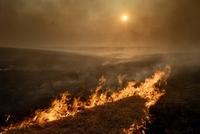Kansas' Flint Hills scenic byway
 Some of the million or so cattle that graze in the Flint Hills’ pastures, once the domain of buffalo, can be seen from the Flint Hills Scenic Byway in Kansas. If you think all of Kansas is flat, then think again and check out the rolling Flint Hills as they fan out across the eastern part of the state over 183 miles from north to south, stretching 30 to 40 miles wide in parts.
Some of the million or so cattle that graze in the Flint Hills’ pastures, once the domain of buffalo, can be seen from the Flint Hills Scenic Byway in Kansas. If you think all of Kansas is flat, then think again and check out the rolling Flint Hills as they fan out across the eastern part of the state over 183 miles from north to south, stretching 30 to 40 miles wide in parts. Seemingly endless, the landscape offers up isolated images — a wind-whipped cottonwood tree, a rusted cattle pen, a spindly windmill, an abandoned limestone schoolhouse, the metal-gated entrance to a hilltop cemetery.
Proud of the region’s beauty, Kansas has seen to it that 48 miles of its Highway 177, leading through the heart of the hills, are designated the Flint Hills National Scenic Byway. The route winds through almost treeless rolling land where bison once roamed; they have been replaced by prairie chickens, great blue herons, coyote, deer, collared lizards, bobcats and, of course, cattle.
This stretch starts about 50 miles northeast of Wichita and leads north to the Tallgrass Prairie National Preserve, one of the few places left in the United States where a visitor can see the grasses that once covered so much of the American heartland. The preserve has over 16 miles of walking trails or you can take a bus tour or roam around the 1881 hilltop ranch with its limestone mansion and an impressive three-story barn.
The route starts in the tiny ranch town of Cassoday (population 130), where the dirt Main Street has a few weathered 19th-century wooden buildings housing an antiques store and a cafe popular with cowboys, truck drivers and bikers. It then goes through a handful of small towns and past the Tallgrass Prairie Preserve to Council Grove, a former staging area on the Santa Fe Trail. More recently, tourist amenities have been upgraded in the Flint Hills, especially in Chase County, made famous by William Least Heat-Moon’s 1991 book “PrairyErth”.
In Cottonwood Falls the two-block shopping district is dominated by the grand Chase County Courthouse, the oldest county courthouse (1873) still in use in Kansas (currently being renovated). Made of native honey-hued limestone with a red mansard roof, it resembles a small chateau.
One of the town’s biggest annual events is the weeklong Prairie Fire Festival, paying tribute to the annual controlled burning to clear out old dry grass and promote new growth, an astonishing sight of flames sweeping through the hills. In the summer and early fall, weekend pioneers can pick up the Flint Hills Overland Wagon Train in Council Grove. Riders camp overnight and are duly fed several “pioneer meals” cooked over an open fire. Saturday night’s entertainment is a performance of cowboy songs and poems.
Learn about visiting the Flint Hills and getting up close and personal with the tallgrass prairie by visiting the Web site of the Tallgrass Prairie National Preserve: Nps.gov/tapr

